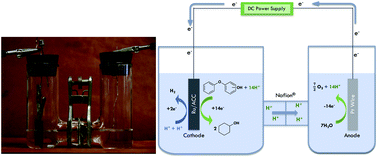当前位置:
X-MOL 学术
›
Sustain. Energy Fuels
›
论文详情
Our official English website, www.x-mol.net, welcomes your
feedback! (Note: you will need to create a separate account there.)
Electrocatalytic cleavage of lignin model dimers using ruthenium supported on activated carbon cloth
Sustainable Energy & Fuels ( IF 5.0 ) Pub Date : 2019/12/19 , DOI: 10.1039/c9se00912d Mahlet Garedew 1, 2, 3, 4 , Daniel Young-Farhat 2, 3, 4, 5 , Souful Bhatia 2, 3, 4, 6 , Pengchao Hao 2, 3, 4, 6 , James E. Jackson 2, 3, 4, 6 , Christopher M. Saffron 1, 2, 3, 4, 5
Sustainable Energy & Fuels ( IF 5.0 ) Pub Date : 2019/12/19 , DOI: 10.1039/c9se00912d Mahlet Garedew 1, 2, 3, 4 , Daniel Young-Farhat 2, 3, 4, 5 , Souful Bhatia 2, 3, 4, 6 , Pengchao Hao 2, 3, 4, 6 , James E. Jackson 2, 3, 4, 6 , Christopher M. Saffron 1, 2, 3, 4, 5
Affiliation

|
Biomass lignin is the largest natural source of renewable aromatic compounds, creating an opportunity for its use as a feedstock provided that deconstruction and upgrading methods become available. Valorization of lignin is challenging because its complex structure is naturally recalcitrant to biological degradation. Deconstruction of this amorphous cross-linked polymer requires cleavage of aryl ether bonds, which account for more than half of the linkages between lignin's phenylpropanoid building blocks. High temperature cracking of lignin is possible via pyrolysis, but linkages such as 4-O-5 bonds are resistant to thermal degradation. Electrocatalytic hydrogenation offers a mild alternative; operated at low temperature and atmospheric pressure, it cleaves ether bonds while saturating aromatic rings with in situ generated hydrogen. To investigate the use of catalytic ruthenium supported on activated carbon cloth to cleave 4-O-5 bonds, model compounds that exhibit this linkage were selected, including 3-phenoxyphenol, 4-phenoxyphenol, 3-phenoxyanisole, and 3-phenoxytoluene. The two phenols, 3-phenoxyphenol and 4-phenoxyphenol, were cleaved and hydrogenated to form cyclohexanol. 3-Phenoxyanisole and 3-phenoxytoluene were also cleaved but with lower conversion rates and cyclohexanol yields. Alkaline electrolyte solutions showed the highest cyclohexanol yields for both substrates. Increasing substrate concentrations from 10 mM to 40 mM increased faradaic efficiency to 25%, while decreasing current density from 100 mA (33.33 mA cm−2) to 20 mA (6.67 mA cm−2) greatly improved the faradaic efficiency to 96%.
中文翻译:

活性炭布上负载的钌对木质素模型二聚体的电催化裂解
生物质木质素是可再生芳香化合物的最大天然来源,只要有解构和提纯方法可用,就可以将其用作原料。木质素的平衡化具有挑战性,因为其复杂的结构自然会阻碍生物降解。解构这种无定形的交联聚合物需要裂解芳基醚键,芳基醚键占木质素的苯基丙烷结构单元之间键合的一半以上。木质素的高温裂解可通过热解来实现,但是诸如4-O-5键之类的键抗热降解。电催化加氢提供了温和的替代方法。在低温和大气压下运行时,它会裂解醚键,同时使芳环饱和原位产生氢气。为了研究负载在活性炭布上的催化钌裂解4-O-5键的作用,选择了表现出这种键合关系的模型化合物,包括3-苯氧基苯酚,4-苯氧基苯酚,3-苯氧基苯甲醚和3-苯氧基甲苯。将两种苯酚3-苯氧基苯酚和4-苯氧基苯酚裂解并氢化以形成环己醇。3-苯氧基苯甲醚和3-苯氧基甲苯也被裂解,但是具有较低的转化率和环己醇产率。碱性电解质溶液对两种底物均显示出最高的环己醇收率。将底物浓度从10 mM增加到40 mM,将法拉第效率提高到25%,同时将电流密度从100 mA(33.33 mA cm -2)降低到20 mA(6.67 mA cm -2))将法拉第效率提高到96%。
更新日期:2020-03-03
中文翻译:

活性炭布上负载的钌对木质素模型二聚体的电催化裂解
生物质木质素是可再生芳香化合物的最大天然来源,只要有解构和提纯方法可用,就可以将其用作原料。木质素的平衡化具有挑战性,因为其复杂的结构自然会阻碍生物降解。解构这种无定形的交联聚合物需要裂解芳基醚键,芳基醚键占木质素的苯基丙烷结构单元之间键合的一半以上。木质素的高温裂解可通过热解来实现,但是诸如4-O-5键之类的键抗热降解。电催化加氢提供了温和的替代方法。在低温和大气压下运行时,它会裂解醚键,同时使芳环饱和原位产生氢气。为了研究负载在活性炭布上的催化钌裂解4-O-5键的作用,选择了表现出这种键合关系的模型化合物,包括3-苯氧基苯酚,4-苯氧基苯酚,3-苯氧基苯甲醚和3-苯氧基甲苯。将两种苯酚3-苯氧基苯酚和4-苯氧基苯酚裂解并氢化以形成环己醇。3-苯氧基苯甲醚和3-苯氧基甲苯也被裂解,但是具有较低的转化率和环己醇产率。碱性电解质溶液对两种底物均显示出最高的环己醇收率。将底物浓度从10 mM增加到40 mM,将法拉第效率提高到25%,同时将电流密度从100 mA(33.33 mA cm -2)降低到20 mA(6.67 mA cm -2))将法拉第效率提高到96%。











































 京公网安备 11010802027423号
京公网安备 11010802027423号